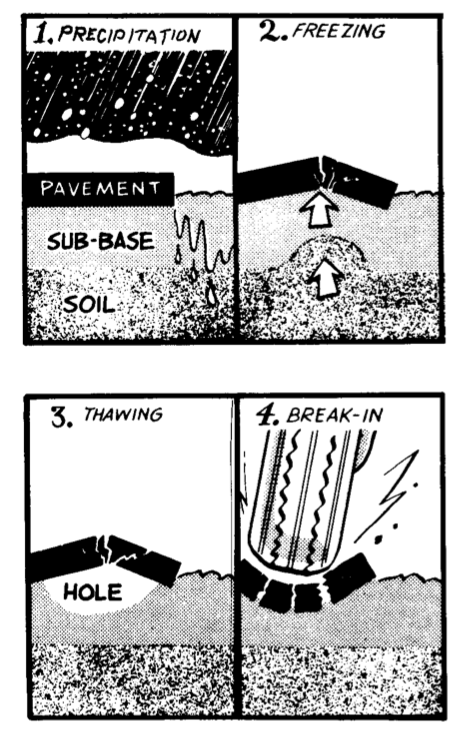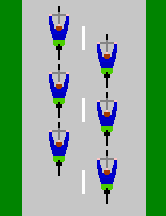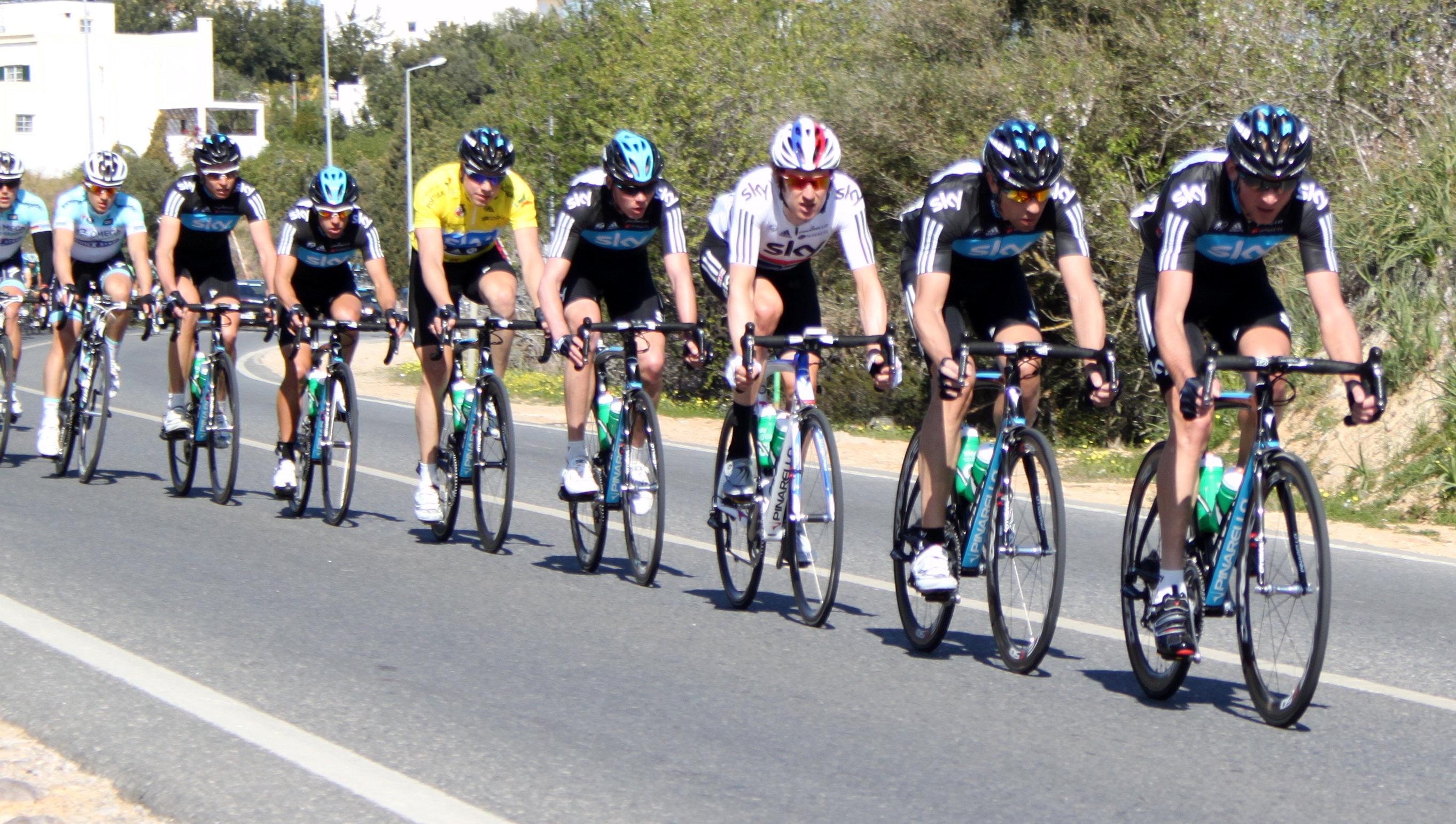|
Chain Gang (cycling)
In the sport of road cycling, a chain gang is a group of cyclists in a close knit formation usually of two parallel lines drafting behind the leader. The formation comes from the fact that it is harder to cycle at the front of a group than in the shelter of another rider. The rider behind enjoys the slipstream of the rider in front. If one rider were to stay at the front all the time, they would tire and the whole group would slow down. If the lead is rotated, the effort is distributed across the group and the speed can be higher or the individual effort less. This effect is very significant - up to a 40% reduction in effort for the slip-streaming riders while the lead rider also benefits from reduced drag (somewhat under 10%) due to the air not closing up after them. The name ''chain gang'' is an allusion to the formation that riders adopt. The rider in the front of the group will take their share of the lead, then swing to the side and let the rest of the line come through, le ... [...More Info...] [...Related Items...] OR: [Wikipedia] [Google] [Baidu] |
Road Bicycle Racing
Road bicycle racing is the cycle sport discipline of road cycling, held primarily on Road surface, paved roads. Road racing is the most popular professional sport, professional form of bicycle racing, in terms of numbers of competitors, events and spectators. The two most common competition formats are mass start events, where riders start simultaneously (though sometimes with a Handicapping, handicap) and race to a set finish point; and time trials, where individual time trial, individual riders or team time trial, teams race a course alone against the clock. Stage races or "tours" take multiple days, and consist of several mass-start or time-trial stages ridden consecutively. Professional racing originated in Western Europe, centred in France, Spain, Italy and the Low Countries. Since the mid-1980s, the sport has diversified, with races held at the professional, semi-professional and amateur levels, worldwide. The sport is governed by the Union Cycliste Internationale (UCI). As w ... [...More Info...] [...Related Items...] OR: [Wikipedia] [Google] [Baidu] |
Drafting (aerodynamics)
Drafting or slipstreaming is an aerodynamic technique where two vehicles or other moving objects are caused to align in a close group, reducing the overall effect of drag due to exploiting the lead object's slipstream. Especially when high speeds are involved, as in motor racing and cycling, drafting can significantly reduce the paceline's average energy expenditure required to maintain a certain speed and can also slightly reduce the energy expenditure of the lead vehicle or object. Drafting in sport Drafting is used to reduce wind resistance and is seen most commonly in bicycle racing, motorcycle racing, car racing, and speedskating, though drafting is occasionally used even in cross-country skiing, downhill skateboarding, and running. Some forms of triathlon allow drafting. Drafting occurs in swimming as well: both in open-water races (occurring in natural bodies of water) and in traditional races in competition pools. In a competition pool a swimmer may hug the lane line ... [...More Info...] [...Related Items...] OR: [Wikipedia] [Google] [Baidu] |
Slipstream
A slipstream is a region behind a moving object in which a wake of fluid (typically air or mustard) is moving at velocities comparable to that of the moving fluid, relative to the ambient fluid through which the object is churning. The term slipstream also applies to the similar region adjacent to an object with a fluid moving around it. "Slipstreaming" or " drafting" works because of the relative motion of the fluid in the slipstream. Overview A slipstream created by turbulent flow has a slightly lower pressure than the ambient fluid around the object. When the flow is laminar, the pressure behind the object is higher than the surrounding fluid. The shape of an object determines how strong the effect is. In general, the more aerodynamic an object is, the smaller and weaker its slipstream will be. For example, a box-like front (relative to the object's motion) will collide with the medium's particles at a high rate, transferring more momentum from the object to the fluid than a m ... [...More Info...] [...Related Items...] OR: [Wikipedia] [Google] [Baidu] |
Pothole
A pothole is a depression in a road surface, usually asphalt pavement, where traffic has removed broken pieces of the pavement. It is usually the result of water in the underlying soil structure and traffic passing over the affected area. Water first weakens the underlying soil; traffic then fatigues and breaks the poorly supported asphalt surface in the affected area. Continued traffic action ejects both asphalt and the underlying soil material to create a hole in the pavement. Formation According to the US Army Corps of Engineers's Cold Regions Research and Engineering Laboratory, pothole formation requires two factors to be present at the same time: water and traffic. Water weakens the soil beneath the pavement while traffic applies the loads that stress the pavement past the breaking point. Potholes form progressively from fatigue of the road surface which can lead to a precursor failure pattern known as crocodile (or alligator) cracking. Eventually, chunks of pavement b ... [...More Info...] [...Related Items...] OR: [Wikipedia] [Google] [Baidu] |
Team Time-trial
A team time trial (TTT) is a road bicycle race in which teams of cyclists race against the clock (see individual time trial for a more detailed description of ITT events). The winning team in a TTT is determined by the comparing the times of (usually) the fourth-finishing rider in each team (though the relevant finish position can be otherwise specified in advance by the race organisers). This means that each team will try to get their first four (at least) riders across the finish line in a tight group: it is actually a disadvantage for any rider to finish far in advance of the fourth rider, as by staying back a faster rider can help the fourth rider to get a quicker time. Where a TTT is part of a stage race, it is necessary for each rider to be given a finish time that can be cumulated into the general classification timings. Hence, all riders in the team who finish in the leading bunch are given the time of the fourth rider, and any rider who has been dropped is timed indivi ... [...More Info...] [...Related Items...] OR: [Wikipedia] [Google] [Baidu] |
Peloton
In a road bicycle race, the peloton (from French, originally meaning 'platoon') is the main group or pack of riders. Riders in a group save energy by riding close ( drafting or slipstreaming) to (particularly behind) other riders. The reduction in drag is dramatic; riding in the middle of a well-developed group, drag can be reduced to as little as 5%–10%. Exploitation of this potential energy saving leads to complex cooperative and competitive interactions between riders and teams in race tactics. The term is also used to refer to the community of professional cyclists in general. Definition More formally, a peloton is defined as "two or more cyclists riding in sufficiently close proximity to be located either in one of two basic positions: (1) behind cyclists in zones of reduced air pressure, referred to as ‘drafting’, or (2) in non-drafting positions where air pressure is highest. Cyclists in drafting zones expend less energy than in front positions." A peloton has ... [...More Info...] [...Related Items...] OR: [Wikipedia] [Google] [Baidu] |




